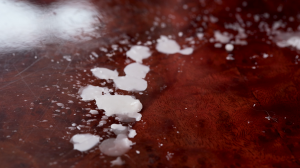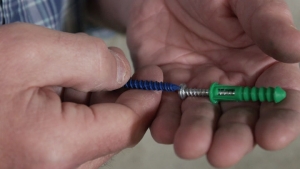How to Remove and Apply Caulks and Sealants Smoothly
The Secret to Getting Smooth Joints on Countertops, Bathtubs and More
Product Information
Currently, BeadTammer, the product shown in the video is unavailable. This is a replacement product ~ Ron CAULK-EZ EZ-4 Caulk Spray Can with Nozzle, Transparent, 2.5 oz
Removing Old Caulk
For my money, the best way to remove old caulk is by cutting it away with a sharp utility knife. You'll want to make two cuts — one, horizontal and one, vertical. This way you can simply lift out much of the old material in a single piece.Next, use a razor blade-style scraper to remove any portion of the old bead still clinging to the surface. This foam sealant remover does a great job of loosening anything that's still left. Just brush it on and wait a few minutes. It works by actually breaking down the bond between the caulk and the surface below. For a final cleaning, a non-metallic abrasive pad like this, does a good job — followed by a wipe with a clean cloth or a paper towel.
Preparing the Surface
Pour some household bleach into a plastic or glass container and brush it into the joint to kill any lingering mildew or mold spores. Let the surface dry thoroughly. Well, we've done a good job of getting the old caulk out and cleaning and preparing the surface.
Applying the New Sealant
Now it's time to put the new caulk in. There are four important steps to getting a professional job. Step one, use the right material.Silicone is my choice for most kitchen and bathroom jobs. This one contains a mold and mildew inhibitor. Cut the tape or tip of the cartridge, just large enough to fill the joint. Using a sharp utility knife, slice on an angle along one of the premarked lines. Many caulking guns have a built-in piercing tool for puncturing the seal at the base of the nozzle. Or you might just try this nifty tip cutter. It adjusts to three different bead sizes. Just slip it over the end of the nozzle and press. The piercing tool folds out from the side of the case. Place the tip of the nozzle into the corner and squeeze the trigger slowly and evenly. Pull the caulking gun toward you and lay down a uniform bead, just large enough to fill the joint.
Smoothing the Joint
Now the fourth and final step to getting a really professional caulking joint is a process called tooling. What you do is take your finger or a tool like this and draw it along the caulking bead. Now, you can see I was really careful putting this in, but there are some spots here where it kind of got caught up on the tile joint, little bumps. The idea here is to smooth that all out. But before you start either with your finger or the tool, spray on some of this. This one-of-a-kind product is called GE Caulk Smoother. It's sprayed on the joint before tooling and lubricates the surface of the silicone, allowing your finger to glide along evenly, leaving behind a perfectly smooth joint. The solution also keeps excess caulk from sticking to surrounding surfaces as well as your skin. This smoothing tool, used in combination with Caulk Smoother also works well and produces a slightly narrower bead than your finger.
Blog Articles
Have You Heard of Landscape Glue?
You love the rustic charm of a gravel walkway, but the constant scattering of stones across your lawn and patio can be a real headache. Whether it’s from pets, lawn mowers, or just foot traffic, it seems impossible to keep those stones in place. Sound familiar? Well, Brian shows us a simple DIY method using landscape glue to keep your gravel path looking pristine and, more importantly, in place.
How to Remove Candle Wax Drips: Two Effective Methods
Candles create a warm and inviting atmosphere, but those pesky wax drips can be a real headache. Luckily, Brian shows us a couple of effective methods to tackle this issue, and they involve two very different temperatures: hot and cold. Here, we'll explore two effective methods: one using cold and the other using heat.
Guide to Hanging on Masonry Walls
Ever wondered how to hang that picture frame or shelf on a brick or concrete wall? It can seem daunting, but with the right tools and techniques, it's a straightforward DIY project. This guide breaks down two common methods: using concrete screws and using anchors, making it easy for you to tackle your next hanging project.





